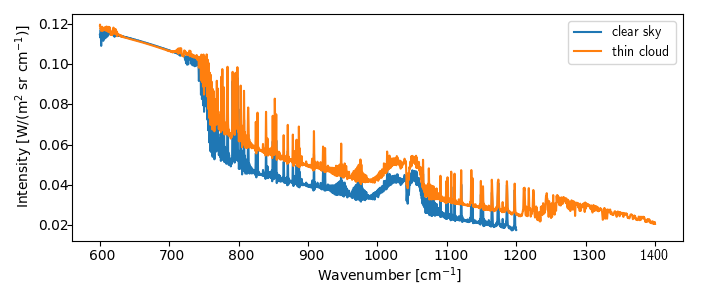SFIT4 emission mode
General
As has been shown elsewhere (Rathke et.al. 2000,
), FTIR spectrometers can be used to record thermal emission from
the atmosphere. This may be used to record amounts of trace gases
in the polar winter (Mariani
et.el. 2013), to evaluate different cloud properties (Rathke
et.al. 2000). Taquet (2017) used sfit4 in
emission mode to retrieve gas contents in a volcanic plume. Most
recently a FTIR in emission mode has been used on a shipcruise in
the Arctic as part of the AC3 coordinated project.
Description of radiative transfer
The emission modul of
SFIT4 calculates the full radiative transfer. Please see the
following scheme for an easy explanation. Basically every layer is
both an absorber and emitter, as described by Kirchhoff's law. To
calculate the spectrum seen at the ground (or any other place) one
has to calculate the sum of the emission of each layer m minus the
absorption on the way from layer m to the observer. The result is
a spectrum where the lines point upward.

One can clearly see the effect of an absorbing layer. It is
reducing the emission coming from beyond the layer and adding a
continuum on it.
For the Jacobian of the spectrum is calculated using
the semianlytic
calculation of the Jacobian . This has the advantage, that the
spectrum and the Jacobian are calculated in n steps. n is the
number of layer, whereas a more tradiational approach by using a
perturbation of the state of each layer would require n**2
calculations.
Modellation of absorbing layers in the atmosphere.
SFIT4
offeres several possibilites to model atmospheric layers in the
atmsophere.
The continuums model I models an absorption which is
proportional to the pressure, i.e. strongest on the ground and
getting less in higher altitude. The absorption layer may be
modelled as an polynomial. This model can be used to account for
unknown absorption, e.g. a continuum of a particula gas, but is
not able to draw any interference about the nature or shape of
this absorption.
The continuums model II models one
layer of an absorber in a specified altitude only. This can be
used to model optically thin clouds. If the atmosphere is overcast
with thick clouds, the cloud bottom servers as an balckbody at the
temperature of its altitude. SFIT4 can to date only retrieve the
optical thinckness of the cloud. Future projects are several other
parameters, which is topic of the
sub-projects B06 in AC3. The use of the continuum to retrieve cloud properties has been described by Rathke et al. 2000
Getting the software
SFIT4 is free to use for everybody and is also a standard
retrieval software used in the NDACC
network . The official version is freely available without
restriction. But the part I am working on is a preliminary
version and subject to frequent changes and bug fixes. Because I
would like to keep track of the people using this particular
version, I distribute the software only on request. I also ask you
not to distribute it further, but to refer interested users to
me. So if you intend to use it write an email to
mathias(dot)palm(at)uni(minus)bremen(dot)de. Especially I ask you
not to publish results using this software without my explicit consent.
References
C. Rathke and J. Fischer,
Retrieval of Cloud Microphysical Properties from Thermal Infrared
Observations by a Fast Iterative Radiance Fitting Method, Journal
Of Atmospheric And Oceanic Technology, Volume 17, 2000

